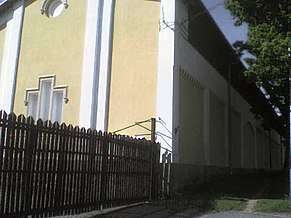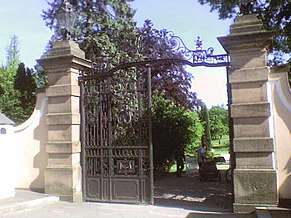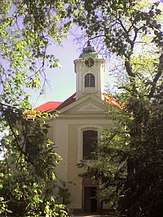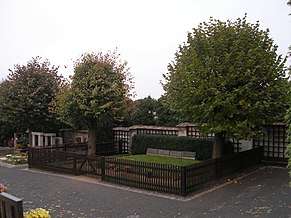Lány (Kladno District)
Lány is a municipality and village in the Central Bohemian Region of the Czech Republic. It has about 2,200 inhabitants. It lies 35 km (22 mi) west of Prague, outside the main road towards Karlovy Vary. Lány is well known for the Lány Castle.
Lány | |
|---|---|
Lány Castle | |
 Flag  Coat of arms | |
 Lány Location in the Czech Republic | |
| Coordinates: 50°7′23″N 13°57′2″E | |
| Country | |
| Region | Central Bohemian |
| District | Kladno |
| First mention | 1392 |
| Government | |
| • Mayor | Karel Sklenička |
| Area | |
| • Total | 34.09 km2 (13.16 sq mi) |
| Elevation | 421 m (1,381 ft) |
| Population (2020-01-01[1]) | |
| • Total | 2,242 |
| • Density | 66/km2 (170/sq mi) |
| Time zone | UTC+1 (CET) |
| • Summer (DST) | UTC+2 (CEST) |
| Postal code | 270 61 |
| Website | www |
Etymology
The word "Lány" in Czech means "fields" or "tracts (of land)".
History
Until 1918, the village was part of the Austrian monarchy (Austria side after the compromise of 1867), in the Schlan (Slaný) district, one of the 94 Bezirkshauptmannschaften (district office) in Bohemia. A post-office was opened in 1869.[2]
The second oldest horse-drawn iron wagonway in continental Europe operated between Prague and Lány (originally planned to reach Plzeň) from 1830 until 1869. Its final station was in present-day forester's lodge of Píně.
Sights
Its major landmark is a castle, serving as a summer residence of Czechoslovak and later Czech Presidents. There is also a sports car museum and Museum of T. G. Masaryk, the first President of Czechoslovakia. Both President Masaryk and his wife are buried in the local cemetery.
Lány Castle
The castle of Lány was first mentioned in 1392. It changed owners many times and underwent a major reconstruction in 1902–1903. In 1921, it was purchased by the Czechoslovak state and designated as an official summer presidential residence. Slovene architect Jože Plečnik was commissioned to make improvements both to the castle and the adjacent park. T. G. Masaryk, the first President, liked the castle and was allowed to stay there after his abdication in 1935 until his death in 1937. From 1921 served as his favourable summer residence.[3] During World War II, the castle was a residence of Emil Hácha, an increasingly ill and incapacitated President of Protectorate Bohemia and Moravia.
The castle was used only rarely during the Communist era. Many valuable artefacts, especially those designed by Jože Plečnik, were discarded during the tenure of Gustáv Husák. Only after the Velvet Revolution did the new President Václav Havel start to come to the castle regularly. Since then, it has been a place of many official sessions between the President and other top politicians.
The castle itself is closed to the public. The castle park is accessible on selected days, including weekends and public holidays.
Transport
The closest train station is Stochov (formerly Lány) about 3 km (1.9 mi) away, still preserving Masaryk's salon used by the President before boarding a train.
Gallery
 Horse stable
Horse stable Castle entry
Castle entry Church
Church Grave of the Masaryk family
Grave of the Masaryk family- MTX Tatra V8 in Sports car museum
References
- "Population of Municipalities – 1 January 2020". Czech Statistical Office. 2020-04-30.
- Die postalischen Abstempelungen auf den österreichischen Postwertzeichen-Ausgaben 1867, 1883 und 1890, Wilhelm Klein, 1967
- Vratislav Preclík: MDH uctilo památku Prezidenta Osvoboditele, in Čas: časopis Masarykova demokratického hnutí, červenec – září 2015, roč. XXIII. čís. 111. ISSN 1210-1648, str. 16 - 17